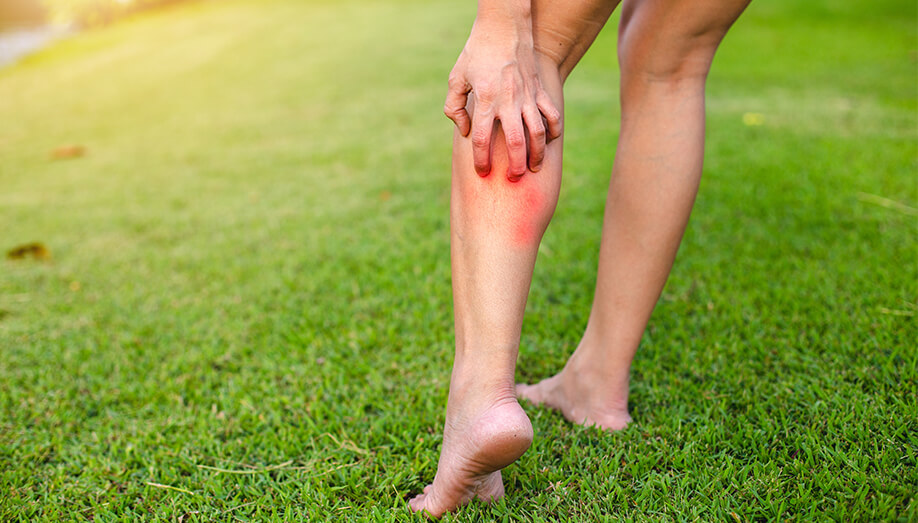
If you have ever experienced a bite or sting, you know it can be an unpleasant experience. Depending on the season, you may notice different activity from different insects, and each kind of insect bite or sting has a unique reaction to the human body. Just the thought of insects creeping and crawling around can make us feel uneasy, however, the bite or sting of one can bring along a variety of physical discomfort.
Once you’ve been bitten or stung, we often wonder what to expect. Here at Sentinel Pest Control, we’ve compiled some of the most common insect bites and stings in the Pacific Northwest to help you learn and identify what you can expect, and ways to prevent them from occurring:
Bed Bug Bites
Bed bugs bite the exposed skin of humans and animals to feed on their blood to survive, typically occurring at night. There are no known cases of disease spread from bed bugs; however, their bites can leave visible signs behind, and they can vary from person to person. In some cases, two people could be bitten by the same bed bugs and have completely different reactions to the bites.
A bed bug bite may consist of the following:
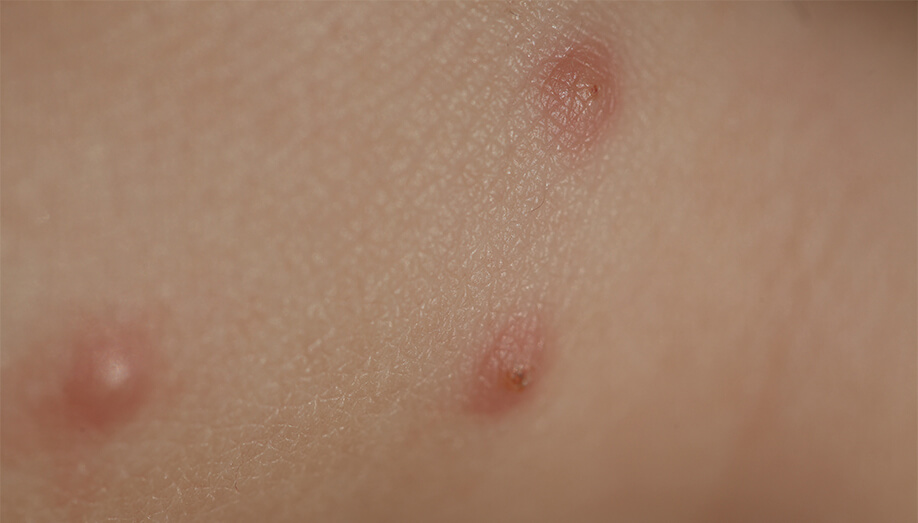
- A raised, itchy bump with a clear center
- Red itchy bump with a dark center and lighter around the surrounding area
- Grouping in a straight line or zigzag pattern
- Burning and itching sensation around the bite marks
In some cases, bites leave no visible marks, and may go completely unnoticed.
Other signs of bed bugs include the appearance of blood spots on clothing or bed sheets, as well as fecal matter, which appears as rust-colored spots on bedding and mattresses.
Bed bugs are a year-round pest. Although they do prefer the warmer temperatures, it is possible to bring bed bugs home any time of the year. There is a reason why it seems bed bug issues increase during the summer: the increase in travel! Bed bugs are the ultimate hitchhikers—they easily travel in suitcases or bags, clothing items, and bedding materials.
Stinging Insect Stings
Stinging insects such as bees, yellow jackets, hornets, and wasps are some of the most common summertime pests. They are very territorial about their nests, and are equipped with a stinger for self-defense. If approached, they may become very aggressive. A yellow jacket or hornet stinger contains venom, and they can sting multiple times; honey bees, on the other hand, can only sting one time.
A stinging insect sting is characterized by the following:
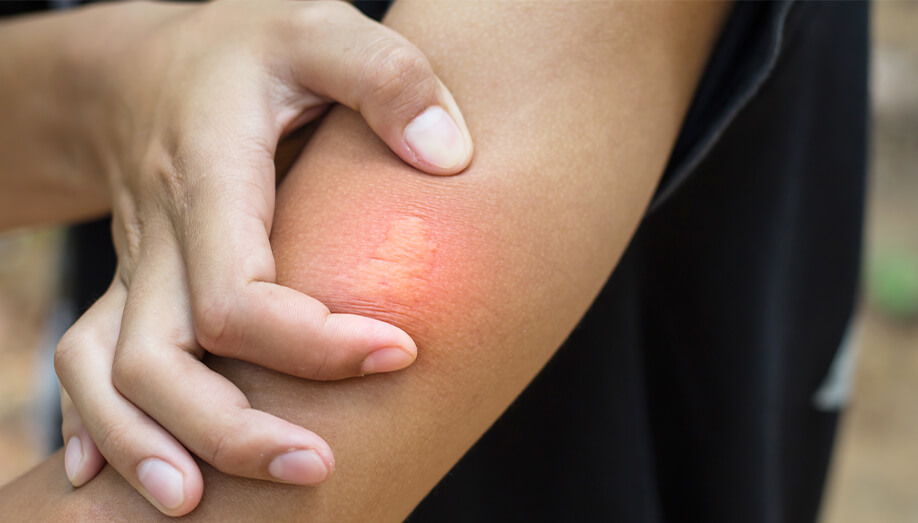
- Instant, sharp burning pain at the sting site
- Redness and welting
- Swelling around the sting area
- Tenderness near the area of the sting
There are different reaction classifications for stings. Normal local reactions, as mentioned above, are the most common reactions to a sting. Large local reactions are more pronounced symptoms from a sting, and can also include nausea and vomiting.
The most severe reaction to the venom from a sting is anaphylaxis, a potentially life-threatening allergic reaction which requires immediate medical attention.
Symptoms of anaphylaxis include:
- Severe swelling to the face, lips, or throat
- Breathing difficulties such as gasping or wheezing
- Nausea or vomiting
- Hives or itching in areas of the body other than the sting site
- Dizziness, lightheadedness, or loss of consciousness
- A sudden drop in blood pressure
Our best recommendation for prevention from a stinging insect sting would be to not approach a nest, and make sure to call a licensed professional such as Sentinel to have an experienced technician safely and effectively remove the nest.
Mosquito Bites
A mosquito bite reaction is caused by a mosquito piercing the skin and injecting saliva into the skin to siphon blood. The proteins from the saliva triggers a mild immune system reaction, which causes the classic bump and itch. Interestingly, only female mosquitoes can bite. This is because they have a mouthpart made to pierce skin and siphon blood, as is required for egg production.
Mosquito bites can show in a few different ways, including:
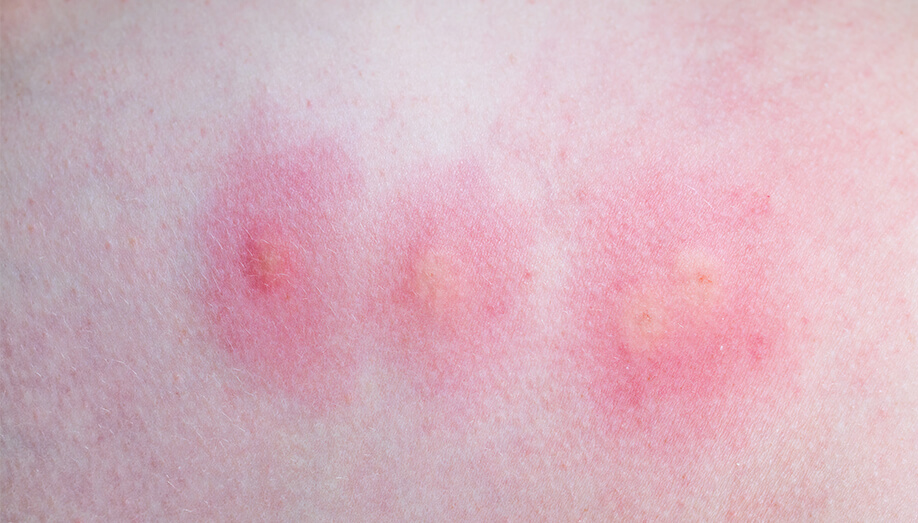
- A puffy white and reddish bump
- A hard-itchy red bump, or even multiple bumps
- A hard blister instead of a bump
You’ll mainly see mosquitoes during the spring and summertime. They can produce more severe reactions in younger children, which can include a larger area of swelling, hives, a low-grade fever, and swollen lymph nodes. Children are more likely to have a severe reaction than adults, as adults may become desensitized through having several bites throughout their lives.
The best way to protect yourself against mosquitoes and the potential diseases they carry is to take the following steps:
- Use insect repellent when you are outdoors
- Wear a long-sleeve shirt, pants, and a hat when going into areas where mosquitoes are high in numbers, such as the woods or wetlands
- Make sure windows and doors are sealed properly, and are screened when open
- Eliminate standing water near your home in places such as clogged gutters, around leaking outdoor faucets and sprinklers, and old tires
Flea Bites
Fleas are small parasites that survive by sucking on the blood of their hosts, such as humans and pets. Adult fleas are wingless; however, they can jump up to one hundred times their body length making them able to travel far distances. Only adult fleas feed on blood, whilst the larvae feed on debris, dust, and lint in carpeting. Fleas can carry disease as well, such as cat-scratch disease (CSD) and, in rare cases, bubonic plague.
A flea bite is characterized as the following:
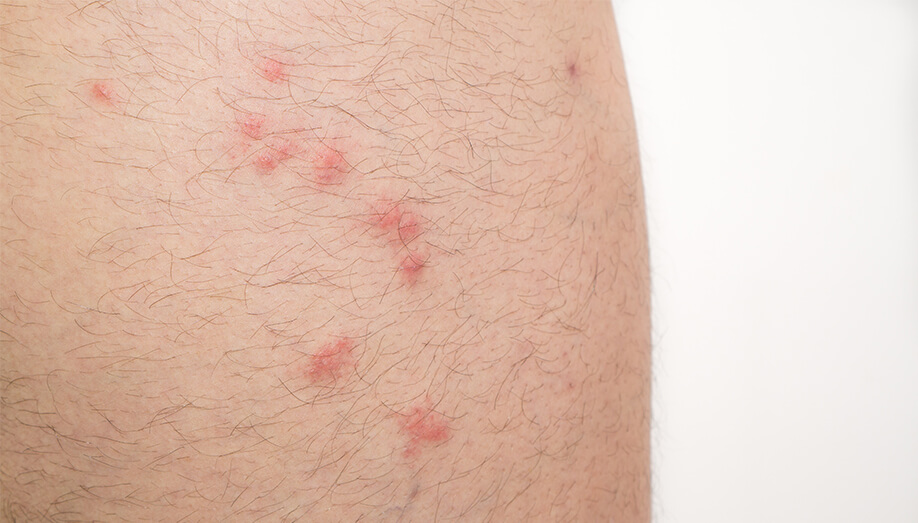
- Red, swollen, intense itching and sometimes painful bumps
- Bite marks that appear in clusters often around the legs or ankles
- Possible bacterial infection from prolonged scratching
The best way to prevent your home from a flea infestation is by the following:
- Keep up regular maintenance of your yard, such as keeping the grass mowed and any vegetation cut back
- If you own pets, make sure to keep up their regular flea protection regime
- Keep your home clean and vacuum at least once a week, as the larvae feed on debris, dust, and lint in carpeting
Spider Bites
In the Pacific Northwest, there are many different species of spiders. Only a few species of spiders have fangs long enough to pierce the human skin; the two here in the Pacific Northwest are the black widow spider and the yellow sack spider. Although spiders are usually not aggressive, they can bite if they feel trapped or accidentally disturbed.
A spider bite is characterized as the following:
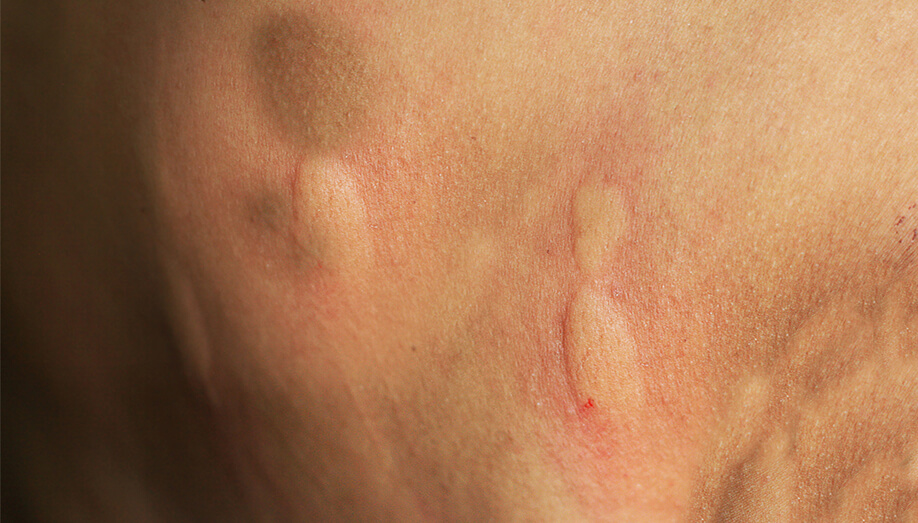
- Itching or rash forming at the location of the bite
- Pain at the location of the bite
- Redness, blisters or bumps
- Look and feel similar to a bee sting
A severe reaction to a spider bite (such as the black widow) can include:
- Muscle pain or cramping
- Sweating
- Difficulty breathing
- High blood pressure
- Fever
- Headache
It is important that you seek medical attention immediately if you suspect you have been bitten by one of the following species:
- Black Widow
- Brown Recluse (do not live in Washington)
- Hobo Spider (although found in Washington, there is no evidence that this species causes skin necrosis)
The best way to prevent a spider infestation in your home is by following these tips:
- Remove any spider webs that you find in your shed or garage
- Keep any woodpiles outside, and check them for spiders before bringing them inside your home
- Wear long-sleeved shirts and pants when you are accessing any wooded areas or clearing out any areas with potential spider activity
- Remove any clutter from around or inside the home
- Eliminate small cracks and openings to your home with a sealant
- Make sure all doors and windows are snug fitting
- If a spider is on you, brush it away and don’t crush it to decrease the chance of its fangs piercing your skin
- Have your home treated regularly by a pest professional
We hope this information helps you to avoid bites or stings from the common pests we see here in the Pacific Northwest. If you’re noticing an abundance of these pests, give Sentinel a call for a free inspection!

If you have ever experienced a bite or sting, you know it can be an unpleasant experience. Depending on the season, you may notice different activity from different insects, and each kind of insect bite or sting has a unique reaction to the human body. Just the thought of insects creeping and crawling around can make us feel uneasy, however, the bite or sting of one can bring along a variety of physical discomfort.
Once you’ve been bitten or stung, we often wonder what to expect. Here at Sentinel Pest Control, we’ve compiled some of the most common insect bites and stings in the Pacific Northwest to help you learn and identify what you can expect, and ways to prevent them from occurring:
Bed Bug Bites
Bed bugs bite the exposed skin of humans and animals to feed on their blood to survive, typically occurring at night. There are no known cases of disease spread from bed bugs; however, their bites can leave visible signs behind, and they can vary from person to person. In some cases, two people could be bitten by the same bed bugs and have completely different reactions to the bites.

A bed bug bite may consist of the following:
- A raised, itchy bump with a clear center
- Red itchy bump with a dark center and lighter around the surrounding area
- Grouping in a straight line or zigzag pattern
- Burning and itching sensation around the bite marks
In some cases, bites leave no visible marks, and may go completely unnoticed.
Other signs of bed bugs include the appearance of blood spots on clothing or bed sheets, as well as fecal matter, which appears as rust-colored spots on bedding and mattresses.
Bed bugs are a year-round pest. Although they do prefer the warmer temperatures, it is possible to bring bed bugs home any time of the year. There is a reason why it seems bed bug issues increase during the summer: the increase in travel! Bed bugs are the ultimate hitchhikers—they easily travel in suitcases or bags, clothing items, and bedding materials.
Stinging Insect Stings
Stinging insects such as bees, yellow jackets, hornets, and wasps are some of the most common summertime pests. They are very territorial about their nests, and are equipped with a stinger for self-defense. If approached, they may become very aggressive. A yellow jacket or hornet stinger contains venom, and they can sting multiple times; honey bees, on the other hand, can only sting one time.

A stinging insect sting is characterized by the following:
- Instant, sharp burning pain at the sting site
- Redness and welting
- Swelling around the sting area
- Tenderness near the area of the sting
There are different reaction classifications for stings. Normal local reactions, as mentioned above, are the most common reactions to a sting. Large local reactions are more pronounced symptoms from a sting, and can also include nausea and vomiting.
The most severe reaction to the venom from a sting is anaphylaxis, a potentially life-threatening allergic reaction which requires immediate medical attention.
Symptoms of anaphylaxis include:
- Severe swelling to the face, lips, or throat
- Breathing difficulties such as gasping or wheezing
- Nausea or vomiting
- Hives or itching in areas of the body other than the sting site
- Dizziness, lightheadedness, or loss of consciousness
- A sudden drop in blood pressure
Our best recommendation for prevention from a stinging insect sting would be to not approach a nest, and make sure to call a licensed professional such as Sentinel to have an experienced technician safely and effectively remove the nest.
Mosquito Bites
A mosquito bite reaction is caused by a mosquito piercing the skin and injecting saliva into the skin to siphon blood. The proteins from the saliva triggers a mild immune system reaction, which causes the classic bump and itch. Interestingly, only female mosquitoes can bite. This is because they have a mouthpart made to pierce skin and siphon blood, as is required for egg production.

Mosquito bites can show in a few different ways, including:
- A puffy white and reddish bump
- A hard-itchy red bump, or even multiple bumps
- A hard blister instead of a bump
You’ll mainly see mosquitoes during the spring and summertime. They can produce more severe reactions in younger children, which can include a larger area of swelling, hives, a low-grade fever, and swollen lymph nodes. Children are more likely to have a severe reaction than adults, as adults may become desensitized through having several bites throughout their lives.
The best way to protect yourself against mosquitoes and the potential diseases they carry is to take the following steps:
- Use insect repellent when you are outdoors
- Wear a long-sleeve shirt, pants, and a hat when going into areas where mosquitoes are high in numbers, such as the woods or wetlands
- Make sure windows and doors are sealed properly, and are screened when open
- Eliminate standing water near your home in places such as clogged gutters, around leaking outdoor faucets and sprinklers, and old tires
Flea Bites
Fleas are small parasites that survive by sucking on the blood of their hosts, such as humans and pets. Adult fleas are wingless; however, they can jump up to one hundred times their body length making them able to travel far distances. Only adult fleas feed on blood, whilst the larvae feed on debris, dust, and lint in carpeting. Fleas can carry disease as well, such as cat-scratch disease (CSD) and, in rare cases, bubonic plague.

A flea bite is characterized as the following:
- Red, swollen, intense itching and sometimes painful bumps
- Bite marks that appear in clusters often around the legs or ankles
- Possible bacterial infection from prolonged scratching
The best way to prevent your home from a flea infestation is by the following:
- Keep up regular maintenance of your yard, such as keeping the grass mowed and any vegetation cut back
- If you own pets, make sure to keep up their regular flea protection regime
- Keep your home clean and vacuum at least once a week, as the larvae feed on debris, dust, and lint in carpeting
Spider Bites
In the Pacific Northwest, there are many different species of spiders. Only a few species of spiders have fangs long enough to pierce the human skin; the two here in the Pacific Northwest are the black widow spider and the yellow sack spider. Although spiders are usually not aggressive, they can bite if they feel trapped or accidentally disturbed.

A spider bite is characterized as the following:
- Itching or rash forming at the location of the bite
- Pain at the location of the bite
- Redness, blisters or bumps
- Look and feel similar to a bee sting
A severe reaction to a spider bite (such as the black widow) can include:
- Muscle pain or cramping
- Sweating
- Difficulty breathing
- High blood pressure
- Fever
- Headache
It is important that you seek medical attention immediately if you suspect you have been bitten by one of the following species:
- Black Widow
- Brown Recluse (do not live in Washington)
- Hobo Spider (although found in Washington, there is no evidence that this species causes skin necrosis)
The best way to prevent a spider infestation in your home is by following these tips:
- Remove any spider webs that you find in your shed or garage
- Keep any woodpiles outside, and check them for spiders before bringing them inside your home
- Wear long-sleeved shirts and pants when you are accessing any wooded areas or clearing out any areas with potential spider activity
- Remove any clutter from around or inside the home
- Eliminate small cracks and openings to your home with a sealant
- Make sure all doors and windows are snug fitting
- If a spider is on you, brush it away and don’t crush it to decrease the chance of its fangs piercing your skin
- Have your home treated regularly by a pest professional
We hope this information helps you to avoid bites or stings from the common pests we see here in the Pacific Northwest. If you’re noticing an abundance of these pests, give Sentinel a call for a free inspection!

